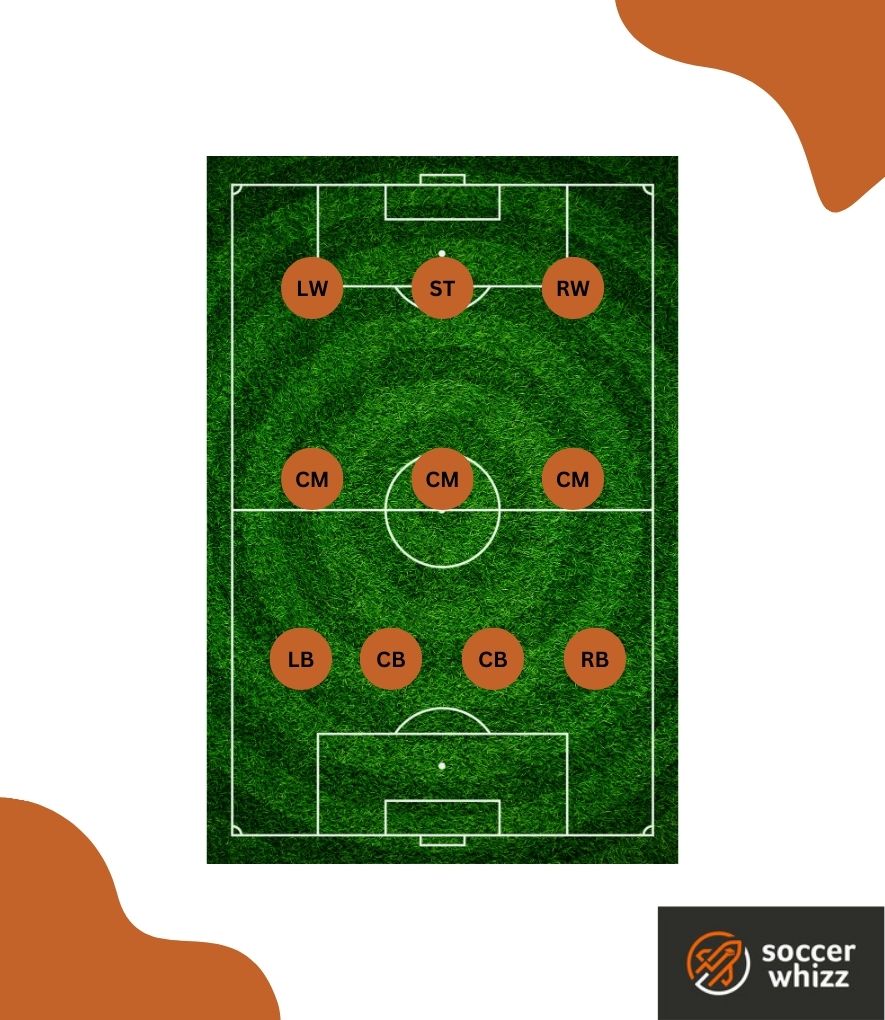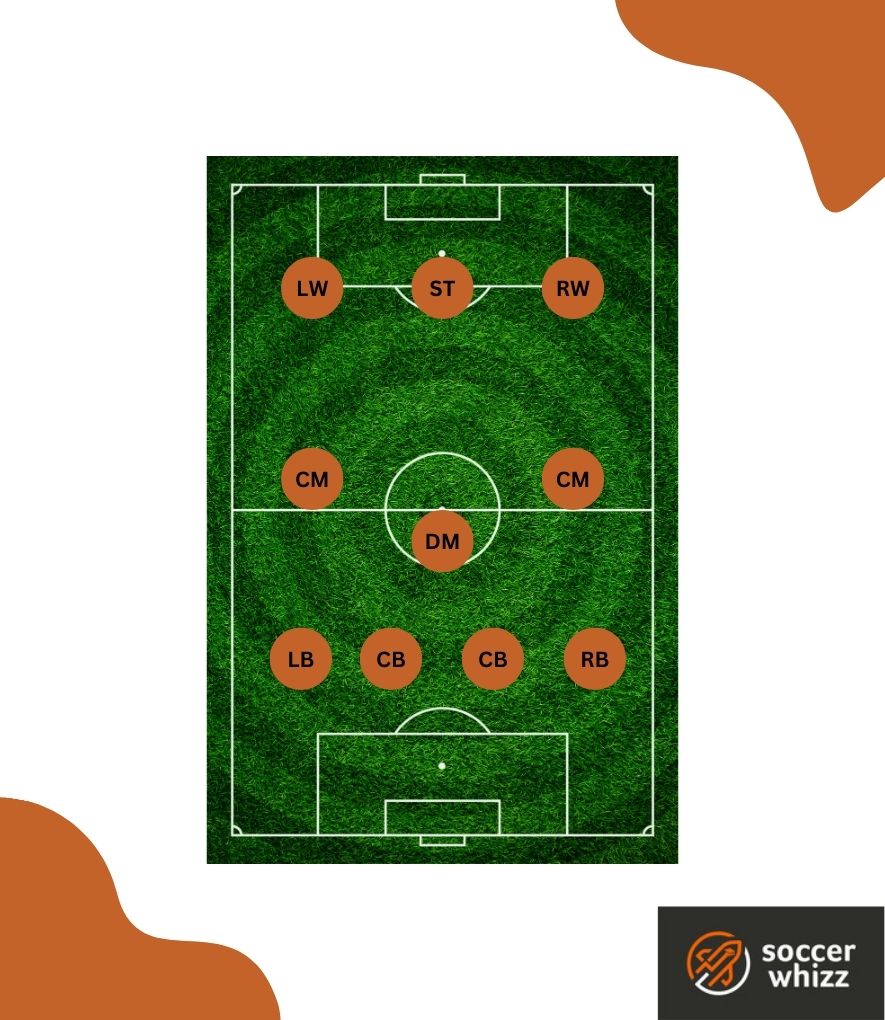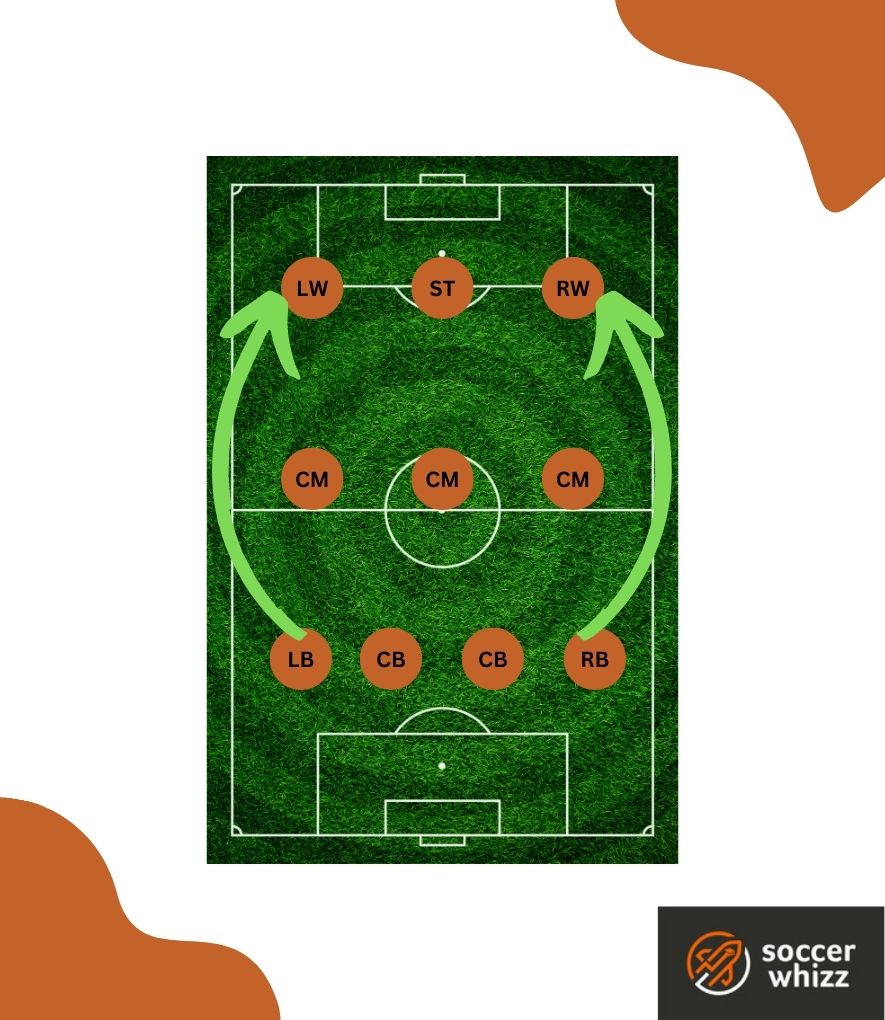Within the game of soccer, tactics play a pivotal role in determining a team’s success on the pitch.
Among the numerous formations employed by coaches worldwide, the 4-3-3 stands as a timeless and revered strategy that has stood the test of time.
This tactical masterpiece has been embraced and celebrated by some of the most illustrious clubs and national teams, paving the way for thrilling encounters and unforgettable moments on the grand stage.
In this in-depth analysis, we embark on an exploration of the 4-3-3 formation – its origins, key principles, and the influential coaches and teams that have elevated it to legendary status.
Who invented the 4-3-3 system?
One of the early adopters of the 4-3-3 system was the Dutch club Ajax Amsterdam, under the management of Rinus Michels.

Michels, often referred to as “The General,” is credited with popularizing the Total Football philosophy, which involved players interchangeably shifting positions and maintaining a fluid formation on the pitch.
The 4-3-3 formation complemented this approach, with players transitioning smoothly between attacking, midfield, and defensive roles.
Ajax’s success with this system during the late 1960s and early 1970s left a lasting impact on the game’s tactical landscape.
The 4-3-3 formation gained further prominence when another Dutch coach, Ernst Happel, used it effectively with the Netherlands national team during the 1974 FIFA World Cup.
Although the Netherlands did not win the tournament, their attractive and attacking style of play left a lasting impression on the footballing world.
How does a 4-3-3 formation work?
The 4-3-3 formation, renowned for its attacking mindset, comprises three vital layers that work in harmony to create a well-balanced setup on the field.
At the foundation, four defenders, consisting of a right-back, two center-backs, and a left-back, shield the goalkeeper, forming a formidable defensive barrier.
Positioned just ahead of them, a trio of central midfielders assumes various tactical arrangements to dictate the flow of the game.
Finally, the frontline is powered by a potent trio, typically featuring two wingers (or inside forwards) flanking a central striker, becoming the focal point during offensive moves.

This strategic layout effectively blankets the entire pitch, creating equilibrium among defensive solidity, midfield control, and attacking prowess.
Yet, it’s noteworthy that coaches may interpret the 4-3-3 differently, adjusting player roles to suit their tactical vision.
One common variation involves deploying one of the central midfielders in a defensive capacity, functioning as a holding midfielder to shield the back four.

Alternatively, for a more aggressive approach, a midfielder can be pushed forward to bolster the attacking line, while the remaining two midfielders operate deeper, providing a solid foundation behind the attacking front.
What are the strengths of a 4-3-3 formation?
The 4-3-3 formation boasts a crucial advantage – enabling teams to apply high-pressure tactics, pressing the opposition’s defense relentlessly in the final third.
This specific attribute has made it the favored choice for tacticians like Jurgen Klopp at Liverpool, who advocate for the intense gegenpressing strategy.
The front three spearhead this pressing onslaught, forcing the opposing team into errors ripe for exploitation.
However, the formation’s creative brilliance extends beyond the attacking trio.
The midfield trio doesn’t merely intercept opposition passes and shield the back four; they also excel in dictating possession and advancing the ball through central areas.
The formation’s shape facilitates the creation of diverse passing angles, thus facilitating the development of intricate ‘tiki-taka’ style football.
Furthermore, the full-backs play a crucial role in offering alternative attacking options.
In this system, they often surge forward, overlapping the central midfielders, and providing width in offensive areas.

Liverpool’s remarkable full-backs, Trent Alexander-Arnold and Andrew Robertson, epitomize this approach, but their success hinges on the defensive cover and passing opportunities provided by the central midfield.
What are the weaknesses of a 4-3-3 formation?
The 4-3-3 formation’s structure can occasionally leave teams somewhat vulnerable in defensive aspects, especially when their full-backs adopt an attacking stance by pushing up high on the pitch.
This vulnerability becomes more pronounced during opposition counter-attacks, posing a significant threat, particularly if the team is playing with a high defensive line.
A notable illustration of this occurred during Aston Villa’s astonishing 7-2 victory over Liverpool in the 2020-21 season.
Here are video highlights of that entertaining Premier League fixture:
Fitness emerges as a critical concern within this system.
If players lack the required fitness to execute effective pressing, implementing the 4-3-3 can prove challenging, as they become susceptible to swift counter-attacks.
The demanding roles of full-backs and central midfielders necessitate exceptional energy and stamina levels, as they cover extensive ground on the field.
Additionally, the full-back positions demand a high level of discipline; if this area is a team’s weak point, the 4-3-3 formation may not be the most suitable choice.
Consequently, this formation can accentuate the dependence on top-quality players, particularly in crucial areas like the central defensive midfielder position.
Why is the 4-3-3 so popular?
The 4-3-3 formation is immensely popular in modern soccer due to a combination of tactical flexibility, balance, and its ability to accommodate attacking flair.
Several factors contribute to its widespread adoption and enduring appeal among teams worldwide:
Attacking potency
The 4-3-3 places a strong emphasis on attacking with three forwards (usually two wingers and a central striker).
This setup allows teams to create multiple goal-scoring opportunities, exploit wide areas, and apply relentless pressure on the opposition’s defense.
With an attacking trident, the formation fosters an aggressive and dynamic style of play that excites fans and often results in entertaining matches.
Versatility
The 4-3-3 is a flexible formation that can be adjusted to suit a team’s strengths and opponents’ weaknesses.
Coaches can tweak the midfield’s tactical setup, such as adopting a more defensive or attacking approach, while the backline can adapt to face different offensive threats.
This versatility makes it easier for teams to adjust their game plan based on specific match situations.
Solid midfield presence
With three central midfielders, the 4-3-3 ensures a strong presence in the middle of the pitch.
This enables teams to control possession, dictate the flow of the game, and launch attacks from a secure base.
The midfield trio’s well-rounded roles in both defense and offense contribute to the formation’s overall balance.
Which are the best historical examples of teams playing this formation?
Three particular sides spring to mind here…
1. FC Barcelona
Under the management of Pep Guardiola, Barcelona achieved tremendous success with their iconic 4-3-3 system.

This team, led by the brilliant midfield trio of Xavi, Andres Iniesta, and Sergio Busquets, along with the lethal attacking trident of Lionel Messi, Pedro, and David Villa, dominated possession and mesmerized opponents with their tiki-taka style of play.
2. Brazil national team
Considered by many as one of the greatest soccer teams ever assembled, Brazil’s 1970 FIFA World Cup-winning squad played a fluid 4-3-3 formation.
With a formidable midfield comprising Pelé, Rivelino, and Gerson, and the attacking prowess of Jairzinho, Tostão, and Pelé himself, they showcased mesmerizing football and captured the World Cup title in Mexico.
3. Ajax Amsterdam
Coached by Rinus Michels and led by Johan Cruyff, Ajax Amsterdam was a powerhouse in the early 1970s, utilizing the 4-3-3 formation with Total Football principles.
This team revolutionized the game with their positional play and fluid movement, leaving a lasting impact on the sport.
Is 4-3-3 the best formation?
The approach to countering the 4-3-3 formation can vary significantly from coach to coach.
The key lies in assessing the strengths of your own team and understanding the weaknesses of the opposition.
Striking the right balance in tactics is the essence of effective football coaching.
Determining whether the 4-3-3 shape is the ultimate formation in football remains a topic of debate.
Undoubtedly, it has served as the foundation for some of the modern era’s greatest teams, exemplified by the likes of Pep Guardiola’s Barcelona, Jurgen Klopp’s Liverpool, and Zinedine Zidane’s triumphant Real Madrid, spearheaded by Cristiano Ronaldo.
Yet, like any tactical approach, the 4-3-3 formation has its vulnerabilities.
Consequently, many top teams today opt for alternative systems, such as the 3-5-2 formation and its variations, finding success in diverse ways.
Amidst these choices, the 4-3-3 formation remains steadfast as one of the most reliable tactical setups in the game.
Concluding thoughts
Ultimately, the 4-3-3 soccer formation stands tall as a timeless and captivating masterpiece that has left an indelible mark on the sport.
From its innovative roots with Dutch footballing legends to its widespread adoption by some of the most iconic teams and coaches in history, the 4-3-3 has proven its tactical brilliance and adaptability on the grandest stages.
As the game continues to evolve, the 4-3-3 formation’s legacy as a reliable, dynamic, and captivating tactical system ensures that its allure will endure for generations to come, continuing to shape the future of soccer as we know it.
For further reading on other four man backlines, have a look at our analysis of the 4-4-2 formation and our breakdown of the 4-5-1 tactical shape.
If you enjoy the content that I create and would like to buy me a coffee, then I’d really appreciate it!
Any money that I earn through this donation will be re-invested into more content for this website.
Additionally, by sending in a donation you’ll also receive a copy of my recently released 190+ page eBook on Soccer Ball Care, as well as be subscribed to our mailing list where you’ll be regularly informed on the latest developments concerning the Soccer Whizz blog.
- Future Icons: Europe’s Emerging Midfield Maestros Set for Glory - December 4, 2023
- Kickstarting a Revolution: How Soccer Transformed the United States Over the Last Four Years - October 7, 2023
- 4-1-4-1 Soccer Formation [Analysis] - September 23, 2023

